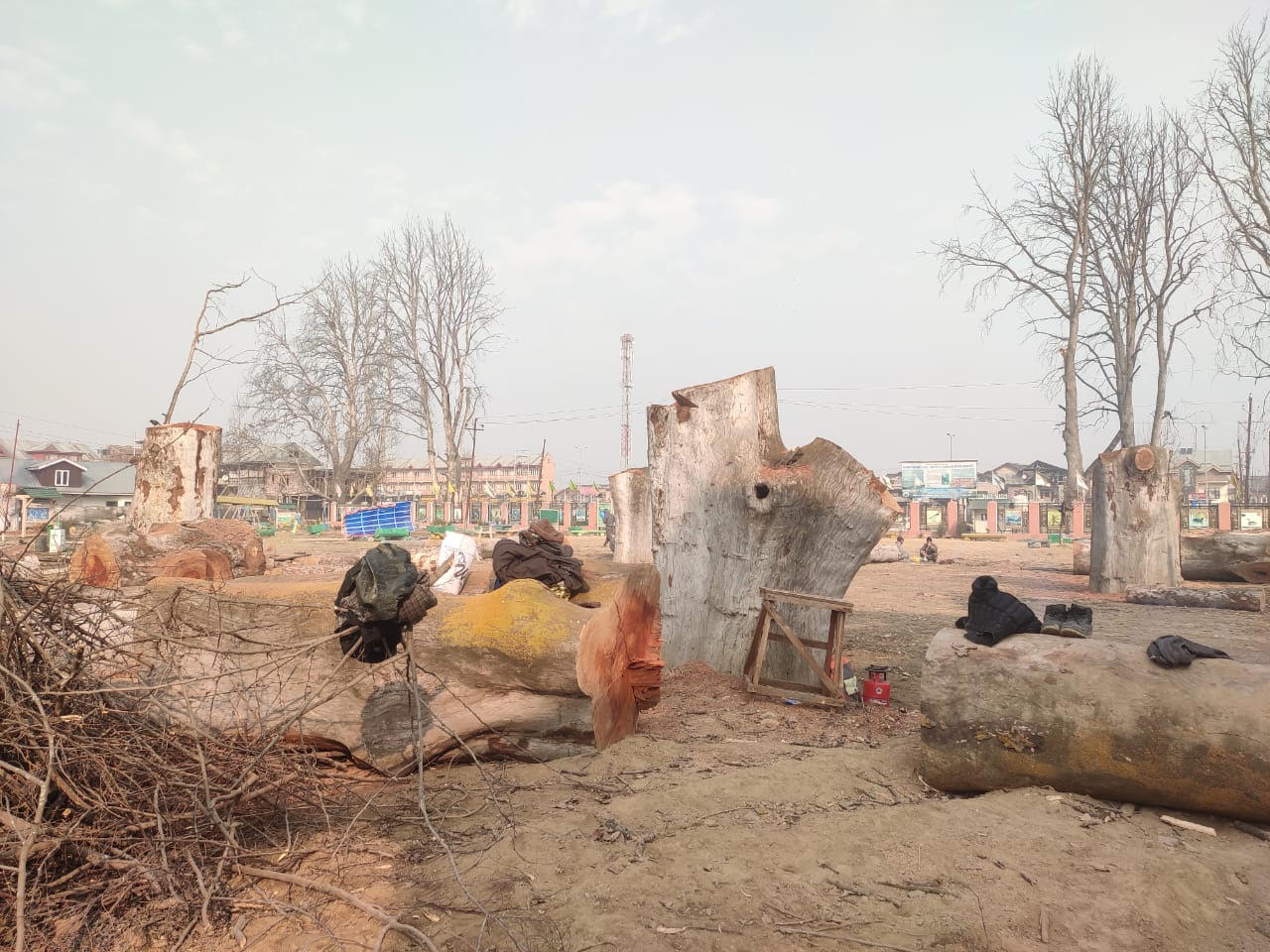Chinar Trees Under Threat: Environmentalists Sound Alarm Over Mass Cutting
By: Javid Amin
Srinagar, February 23, 2025 – The felling of Chinar trees in Kashmir has ignited widespread public outrage, raising serious concerns over heritage conservation and environmental sustainability. The administration, however, dismisses the uproar, insisting that the practice is mere ‘pruning’ of dried branches. The conflicting narratives have sparked fierce debates, with environmental activists, political leaders, and local residents demanding accountability.
Geo-Tagging Initiative vs. Mass Cutting: Contradictions in Policy
Just months ago, the Jammu & Kashmir administration launched the ‘Tree Aadhaar’ initiative, a geo-tagging effort meant to preserve the region’s Chinar population. Despite these conservation efforts, reports of mass felling have surfaced in south Kashmir’s Anantnag district. Residents have voiced frustration over the administration’s apparent duplicity—while policies on paper emphasize preservation, on the ground, Chinar trees continue to be cut down at an alarming rate.
Alarming Reports: Chinar Trees Felled Under the Guise of ‘Pruning’
Photographs and videos circulating on social media from Rani Bagh, Anantnag, show massive Chinar trunks lying on the ground. Locals allege that permission granted for pruning dead branches was exploited to extract maximum wood by cutting entire trees. Given that Chinar wood is highly prized for its durability and aesthetic appeal in carving and sculpting, many suspect that economic motives are at play.
“This is not pruning, it is the mass killing of trees,” lamented Mohammad Aslam, a local resident. His sentiments are echoed by several environmental activists who claim that the felling of mature Chinar trees is an irreversible ecological and cultural loss.
The Legacy of the Chinar: More Than Just Trees
The Chinar tree, locally known as Boueen (Platanus orientalis), is an intrinsic part of Kashmir’s landscape and cultural heritage. These trees, which can reach heights of 30 meters and boast trunk diameters of 10–15 meters, take over 150 years to fully mature. In the past, their canopies shaded Mughal gardens, Sufi shrines, and public squares, adding to Kashmir’s timeless charm.
As per government geo-tagging data, approximately 28,500 Chinar trees remain in Kashmir today. However, past surveys painted a much greener picture—between 42,000 and 45,000 trees once graced the Valley. The rapid decline in numbers highlights the urgent need for stronger conservation measures.
The Legal Dilemma: Chinar Protection Laws in Question
Under the Jammu and Kashmir Preservation of Specified Trees Act, 1969, felling Chinar trees is prohibited unless explicitly permitted by district authorities in cases where the tree poses a threat to life or property. This law was originally enacted to prevent indiscriminate destruction, yet recent incidents suggest that enforcement remains weak.
Member of the Legislative Assembly (MLA) Bashir Ahmad Veeri has urged authorities to take immediate action. “These pictures must be reported to the National Green Tribunal. The Deputy Commissioner of Anantnag must initiate a high-level inquiry, book the culprits for vandalizing public property, and impose heavy fines as a deterrent,” he stated.
Administration’s Response: ‘Factually Incorrect and Baseless’
Mazhar Mustafa Ansari, the district floriculture officer, dismissed allegations of unlawful felling. “Misleading information is being circulated regarding tree felling in Rani Bagh. These claims are factually incorrect. We had written to the Deputy Commissioner and obtained permission for pruning dry branches,” he asserted.
However, environmental groups remain unconvinced, arguing that the sheer number of felled trees contradicts the ‘pruning’ claim.
Activists Raise Red Flags: The Growing Crisis
The Environmental Policy Group (EPG), a leading civil society organization advocating for ecological preservation, has condemned the felling of centuries-old Chinars as a ‘deeply distressing’ event. The group highlighted that these trees hold immense historical, cultural, and ecological value, warning that their destruction is a blatant violation of conservation laws.
EPG further pointed out that similar incidents have occurred in the name of infrastructure development. The widening of the Narbal-Delina road led to the uprooting of over 100 Chinar trees, while several others were felled near Hokersar Wetland to make way for a parking area.
Tourism, Development, and the Cost of Environmental Neglect
Kashmir’s tourism sector depends heavily on its breathtaking natural beauty. The loss of Chinar trees not only threatens biodiversity but also diminishes the Valley’s unique aesthetic appeal. Additionally, Chinars play a vital ecological role—providing shade, reducing air pollution, and stabilizing soil against erosion. Their destruction for short-term economic or infrastructural gains could have long-lasting consequences.
Public Outcry and Demands for Action
The outrage has reached political circles, with PDP leader Iltija Mufti strongly criticizing the government’s stance. “On even days, the J&K government geo-tags Chinar trees to promote conservation. On odd days, they allow 500-year-old trees to be cut down in the name of development. This hypocrisy is infuriating,” she wrote on X (formerly Twitter).
The EPG has demanded an independent investigation into the recent felling of Chinars and a reassessment of all infrastructure projects leading to tree loss. “All those responsible must be held accountable under the law,” the group asserted.
Conclusion: The Need for Stringent Conservation Policies
The ongoing controversy surrounding the Chinar tree felling highlights the larger struggle between environmental conservation and rapid urban development. Unless strict policies are implemented and enforced, Kashmir risks losing a crucial part of its natural and cultural heritage.
The administration must take a transparent approach, ensuring that conservation laws are upheld while allowing for necessary urban development without harming the region’s ecological balance. Stronger penalties for illegal tree felling, increased public awareness, and alternative infrastructure planning methods can help strike a balance between growth and preservation.
The fate of Kashmir’s Chinar trees remains uncertain. However, one thing is clear—without immediate intervention, future generations may only see these majestic trees in photographs, rather than under their comforting shade.



